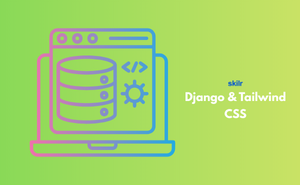👇 CELEBRATE CLOUD SECURITY DAY 👇
00
HOURS
00
MINUTES
00
SECONDS

The Django & Tailwind CSS certification equips learners with the skills to build full-stack web applications that are powerful on the inside and visually appealing on the outside. Django provides the tools to manage complex data and logic, while Tailwind CSS offers an easy way to design responsive, modern, and mobile-friendly interfaces.
Think of Django as the backbone of the website and Tailwind CSS as the skin and clothes that make it presentable. Mastering both ensures developers can deliver complete web solutions — functional, secure, and visually engaging — which is essential in today’s competitive digital world.
This exam is ideal for:
Domain 1 - Introduction to Django & Tailwind CSS
Domain 2 - Django Fundamentals
Domain 3 - Tailwind CSS Basics
Domain 4 - Building UI with Tailwind CSS
Domain 5 - Integration of Django with Tailwind
Domain 6 - Authentication and User Interfaces
Domain 7 - Advanced Features
Domain 8 - Deployment and Optimization
Industry-endorsed certificates to strengthen your career profile.
Start learning immediately with digital materials, no delays.
Practice until you’re fully confident, at no additional charge.
Study anytime, anywhere, on laptop, tablet, or smartphone.
Courses and practice exams developed by qualified professionals.
Support available round the clock whenever you need help.
Easy-to-follow content with practice exams and assessments.
Join a global community of professionals advancing their skills.
Learning Django and Tailwind CSS equips developers with versatile skills that are in demand across multiple domains. These tools allow developers to handle both backend and frontend development, making them valuable assets for organizations seeking professionals capable of building complete web applications.
For Django, developers need proficiency in Python, understanding the MVT (Model-View-Template) architecture, ORM for database interactions, and knowledge of REST API development. For Tailwind CSS, a solid grasp of utility classes, responsive design principles, and component-based styling is crucial. Additionally, familiarity with integrating frontend frameworks with Django templates is essential.
Django is a powerful backend framework for building scalable and secure web applications, while Tailwind CSS simplifies frontend design with its utility-first approach. Combining these tools allows developers to create full-stack applications with a seamless integration between backend functionality and modern, responsive UI designs, making it highly relevant for today’s web development needs.
Full-stack developer roles, web application developers, and software engineers often require expertise in Django and Tailwind CSS. These skills are also in demand for positions in startups, SaaS product development, and freelance web development, where end-to-end development is crucial.
The job market values developers who can deliver robust, scalable backend solutions using Django and aesthetically pleasing, responsive frontends with Tailwind CSS. This combination is highly sought after in industries like eCommerce, EdTech, and enterprise-level applications, where a balance between performance and user experience is critical.
Absolutely. Django's rapid development capabilities combined with Tailwind’s speed in designing UI make this pair ideal for freelance developers and entrepreneurs building MVPs, websites, or scalable applications. These tools save time and offer cost-effective solutions, which is essential for small projects or startups.
Industries such as FinTech, eCommerce, healthcare, and SaaS platforms benefit significantly from Django and Tailwind CSS. These sectors demand secure, scalable backend systems with visually appealing and user-friendly interfaces, both of which this combination excels at delivering.
Integrating Tailwind CSS into Django templates can be challenging for beginners, particularly when managing static files and ensuring compatibility with Django’s templating engine. Additionally, mastering Django’s ORM and database relationships requires practice, while understanding Tailwind's advanced customizations may take time.
Yes, many remote opportunities require Django and Tailwind CSS expertise. Companies globally hire developers for full-stack projects, and the ability to work independently while delivering quality backend and frontend solutions makes these skills particularly attractive for remote roles.
With the increasing need for scalable, secure, and user-friendly web applications, the demand for Django and Tailwind CSS is expected to grow. As both technologies continue to evolve, they remain relevant in creating modern web solutions, ensuring a steady demand for skilled professionals in this space.